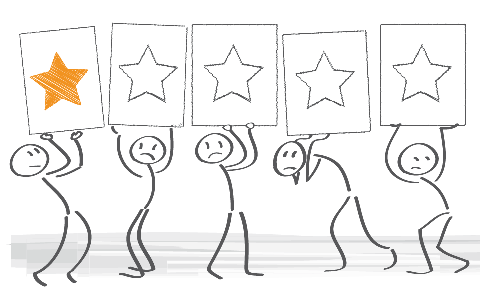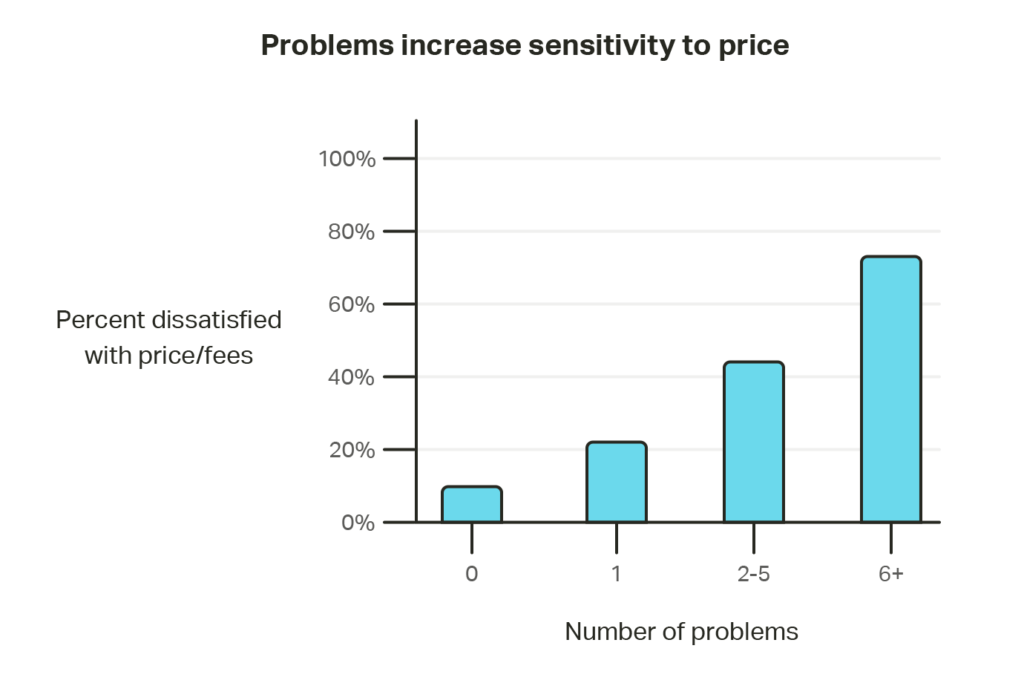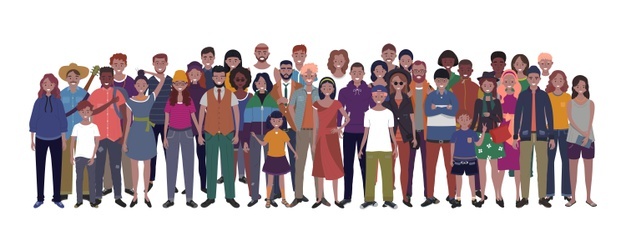
Poor customer service creates a leak in your organization, causing potentially loyal customers to slip away. In other words, poor service will cost your organization money. Lots of money.
You incur this cost in two ways . . .
- Your customers won’t come back
- Your customers won’t recommend you to anyone
So where is all the lost money going?
1. Direct loss of sales
Have you ever tried to buy something from an organization, and their service became so poor that you left? For example, you waited so long on a queue, became frustrated and left. Or your organization loses a contract because your representatives seemed uncaring. These are typical examples of direct loss of sale due to poor service.
Lost sales are the first way poor service is shrinking the bottom line. People will just leave and go elsewhere.
This is true for online businesses just as much as offline businesses. On average, roughly 80% of people will not complete a transaction due to poor customer service. That’s four out of five.
2. Ruined reputation as poor service spreads like wildfire
The word-of-mouth behavior of dissatisfied customers is often underestimated. Study shows that customers who are dissatisfied tell twice as many people about their dissatisfaction as those who are satisfied. Hence bad news travels faster than good.
Poor service means bad word-of-mouth, which means you potentially lose customers who may have purchased from your organization had their friend not ruined the reputation of your organization.
3. Sabotaged second chance
58% of customers will never use a company again after a bad experience. And many customers who are dissatisfied don’t complain. Research shows that 90% of dissatisfied customers do not complain and most show their dissatisfaction by not buying again.
Unfortunately, the 10% who do organizations a favour by complaining are sometimes ignored with their complaints not well handled. When you ignore your customers’ complaints, you’re losing the opportunity to quickly solve the problem that will potentially retain the 90% who do not complain.
In other words, you need to listen to the people who are talking to you and ensure you fix the problem for them as well as anyone else who may have experienced it, but didn’t say anything. If not, people will complain about you to everyone but you, and be taking their business elsewhere.
Please note this: Always assume other people have the same problem as the customers who reach out to you.
4. Increased sensitivity to price
Research from CX Act (formerly TARP Worldwide), found that additional problems increased customers’ sensitivity to price, price changes, and additional fees. Shown below is a survey from retail banking customers.
Research from CX Act (formerly TARP Worldwide), found that additional problems increased customers’ sensitivity to price, price changes, and additional fees. Shown below is a survey from retail banking customers.

Hence with poor service, it’s going to be difficult (if not impossible) to charge a premium or change your pricing structure because poorly treated customers are more sensitive to price changes than well treated ones.
These four outcomes highlighted above are like ‘drainpipes’ inadvertently switched on by poor service, with employees playing a critical role.
Preventing poor service requires great attitude and excellent customer service skills. Do your employees have them?
Written by:
Nkem Anigbogu
E: nanigbogu@learnsmart.com.ng
Tel: 08164459492
*If you’d like your team to have our customer service training shown below which I facilitate, please feel free to contact me.
What Customers Really Want–And How to Deliver It

Course Overview
When your customer does not return, what your organization loses is not just the money for the next transaction but the total revenue the customer would have brought to your organization across their entire relationship with you. This is a huge loss, which is even more when you imagine this scenario for multiple customers.
All this starts when the services provided do not meet the customer’s expectations. And it’s primarily because many employees:
- Do not understand what customers really want
- Understand what customers want but do not know how to deliver it
- Understand what customers want, know how to deliver it, but have bad attitude
This course is designed to address these issues. It will help employees understand, from first principles, what customers really want. It does not stop there. It goes a step further to help them master how to deliver it to make customers satisfied. But since it’s not enough to make customers just satisfied, the course goes another step to arm employees with the skills required to make customers highly satisfied so they return repeatedly.
Unlike the typical customer service training, this one goes beyond learning the niceties of front desk service to explore the concepts and culture of service excellence and how to translate them into every behavior and action that employees understand. It is not designed just for those who have direct interaction with external customers but also for those who contribute in producing service outcomes.
It explores the lifetime value of a customer, the cost of poor service, value from the customer’s perspective, and all other concepts that help change the attitude of participants towards service.
Delivered in different formats, this highly valuable course offers an optimal blend of all the key skills your employees must possess if you’re to stop the losses associated with substandard service, and build your business around the element that matters most – loyal customers.
Training Objectives
After completing this course, participants will:
- Master the basic principles of service
- Understand what customers really want
- Be able to build service standards for their organization
- Be able to deliver what customers want
- Make their customers loyal
- Be able to assess the current performance of their organization in terms of service
- Together with co-employees, be able to move their organizations to a world class status
- Apply effective recovery strategies when things go wrong
- Have the right attitude towards service to customers
- Understand value from the customer’s perspective and apply effective techniques to increase it beyond the reach of competitors
Course Outline
Session 1: Course Overview
- Learning Objectives
- Pre-Assignment
- Pre-Course Assessment
Session 2: Understanding Service
- What service means
- Who is your customer?
- Lifetime value of a customer
- Practice: Estimating lifetime value
Session 3: The Service Concept
- Understanding the service concept
- Customer experience
- Service outcome
- Benefits, Emotions, Judgments and Intentions
- Case Exercise
Session 4: Controlling Customer Experience
- “Moments of Truth”
- Speed
- Responsiveness
- Communication
- Friendliness
Session 5: Controlling Service Outcome
- Service processes
- Reliability
- Competence
- Value
Session 6: Where My Organization Stands
- The service matrix
- Analyzing the service matrix
- In which quadrant is your organization currently?
- Where would you want your organization to be?
Session 7: Building Service Standards
- So, what do customers really want?
- Translating to service standards
- Developing your service standards
- Practice: Your service standards
Session 8: Achieving Loyalty
- Why satisfied customers are not loyal
- The relationship between satisfaction and loyalty
- Ideal relationship
- Real relationship
- The pathway to loyalty
- Case: The car servicing
Session 9: When Things Go Wrong
- Poor service
- The cost of poor service
- Service recovery
- The impact of recovery on loyalty
Session 10: The Value Perspective
- The concept of value
- Understanding value from customers’ perspective
- The ingredients of value
- Increasing value for the customer
Session 11: A Personal Action Plan
- Starting Point
- Key Things I Learned
- What I Want to Improve on the Job
- How I Will Do It
- Summary
- Post-Course Assessment
If you’d prefer to have the course delivered online, please visit the course page for more information.